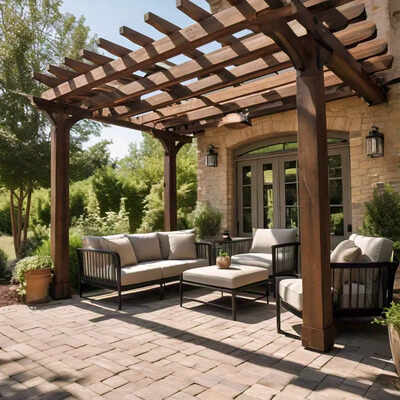- News
- lifestyle
- home-garden
- Enhancing emotional wellbeing through Hardscape design
Trending
Enhancing emotional wellbeing through Hardscape design
Transforming barren urban spaces into inviting areas through balanced design enhances public connection, inclusivity, and emotional well-being. Thoughtful hardscaping integrates visual harmony, accessibility, and seasonal adaptability, making outdoor spaces more functional and welcoming year-round.

Thoughtfully landscaped spaces in urban areas encourage people to connect with their environment. In this way, they also impact people's first impressions of a location, be it a public area, a neighbourhood, or a street in the community.
People naturally gravitate towards well-designed open public areas. Spacious walkways with lively vendors naturally attract crowds whereas, uneven pavements, open drains, and broken kerbs are off-putting The most cherished spaces are those around trees, with small structures serving as seating. Similarly, courtyards are the heart of our public buildings, bustling with activity and life.
Incorporating hardscapes into outdoor spaces requires a focus on inclusivity. Accessible design is important to ensure everyone can benefit from and enjoy these spaces to the fullest, regardless of mobility. Using longer walkways, ramps, and textured surfaces are also part of design elements that promote independence while enhancing emotional health. When outdoor places are inclusive, everyone may thrive and connect with nature in a more welcoming and inspiring environment.
Visual Connection: Hardscapes create harmony between built and unbuilt spaces by enhancing a place's functionality and complementing natural elements.
Physical Touch: Textured pavers are superb for defining a space inspired by earthen materials. Additionally, they provide clear guidance and help avoid hazards.
Sound and Smell: The harmonious blending of natural sounds like water features and raindrops with well-designed hardscaping can intensify or soften their impact. The scent of damp soil and blossoming flowers becomes even more enchanting in a welcoming and accessible environment.
Emotional Well-Being: A thoughtfully planned outdoor area may induce calm, excitement, or nostalgia, all contributing to emotional well-being. Comfort is aided by the colour selection based on the intended use and the local climate. Warm earth tones, for example, can give a space a calm, grounded vibe, while more extensive designs might enlarge another.
Additionally, hardscape design should be sensitive to seasonal adjustments. That way, any outdoor space will always remain welcoming throughout the year. Design elements such as pergolas or shade structures add comfort in hot months, and fire pits extend usability into the colder seasons. This approach lets more people enjoy their outdoor surroundings because time spent outside has been linked to improved moods and reduced stress.
In a nutshell, the design of hardscaped spaces in urban environments intends to influence people's perceptions and interactions with their environment in a long-lasting way — and not merely for aesthetic reasons. These areas set the tone for subsequent encounters by acting as the initial point of contact with a location. As a result, their careful planning and implementation are essential to creating meaningful and constructive relationships in our urban settings.
By: Jubin Shah, Managing Director and CEO, Istaka
End of Article
FOLLOW US ON SOCIAL MEDIA










